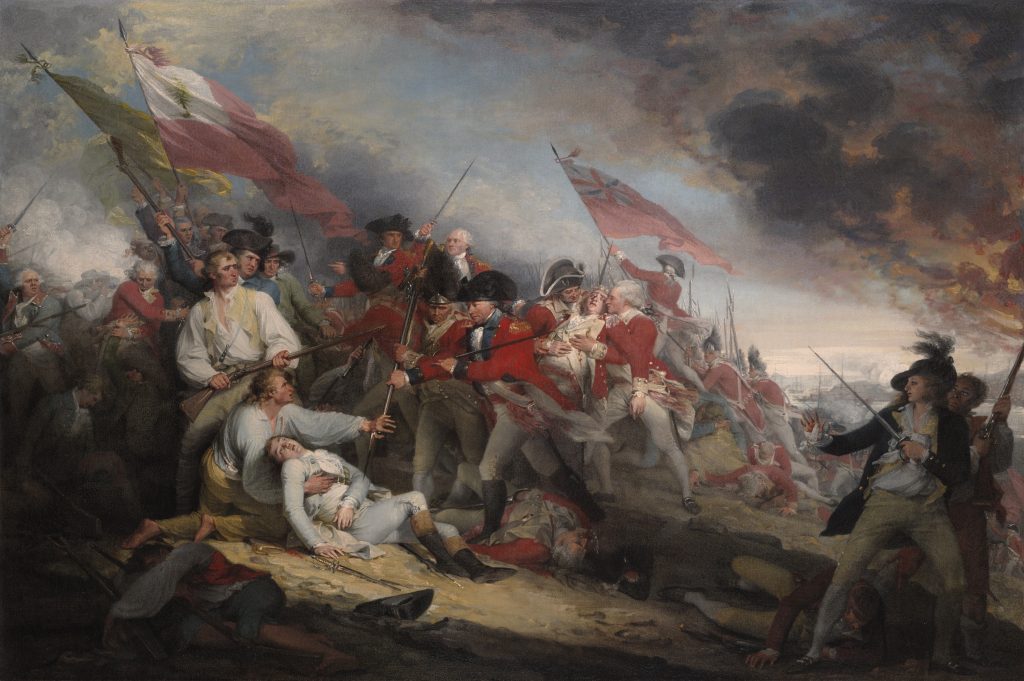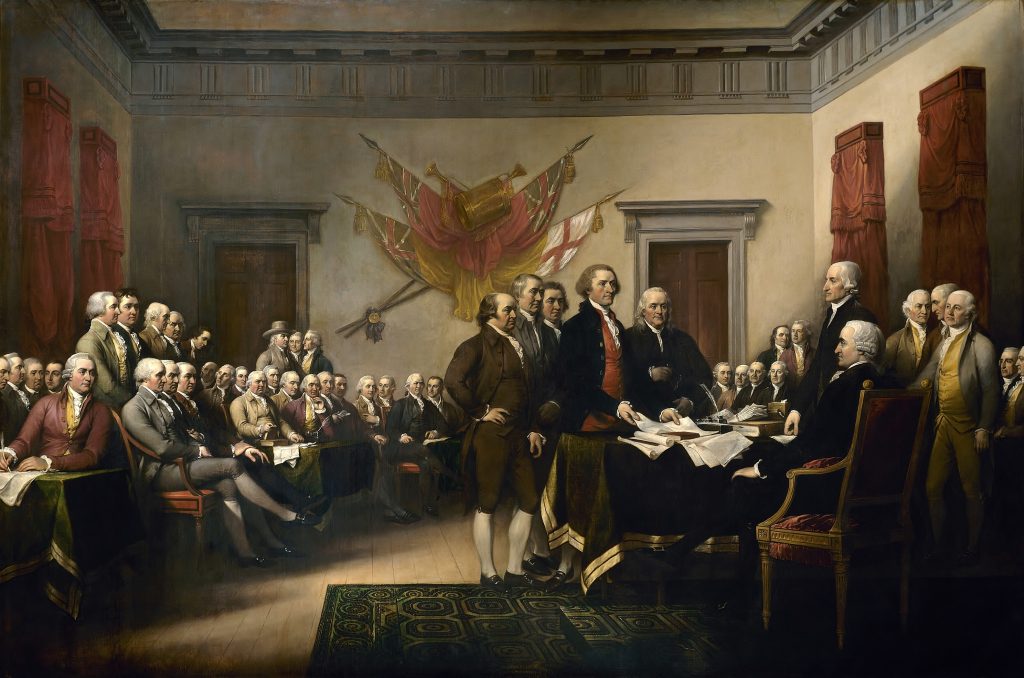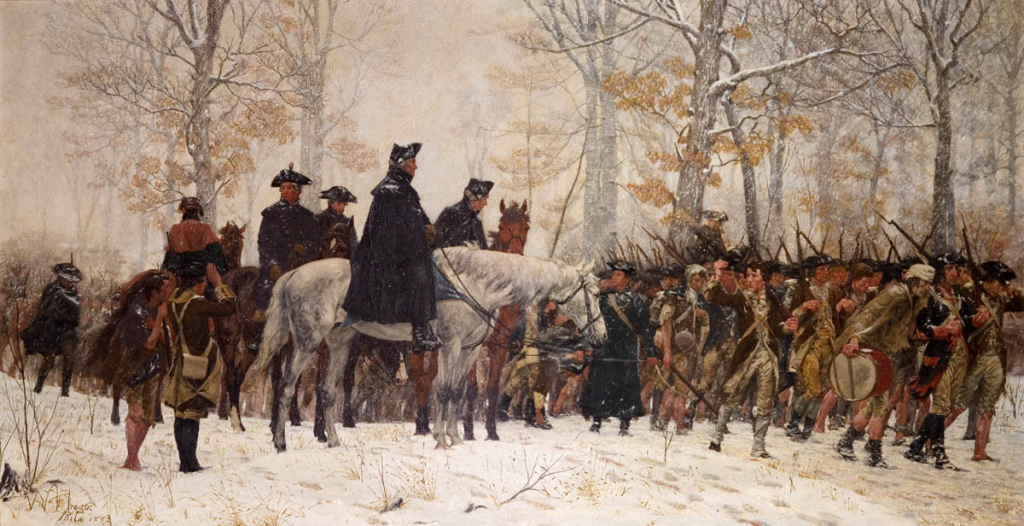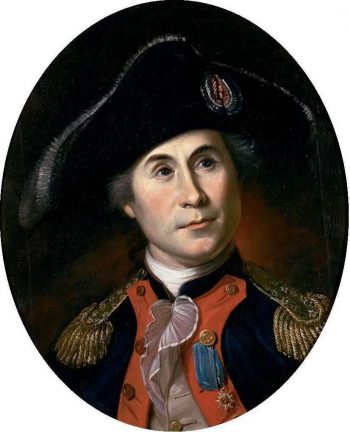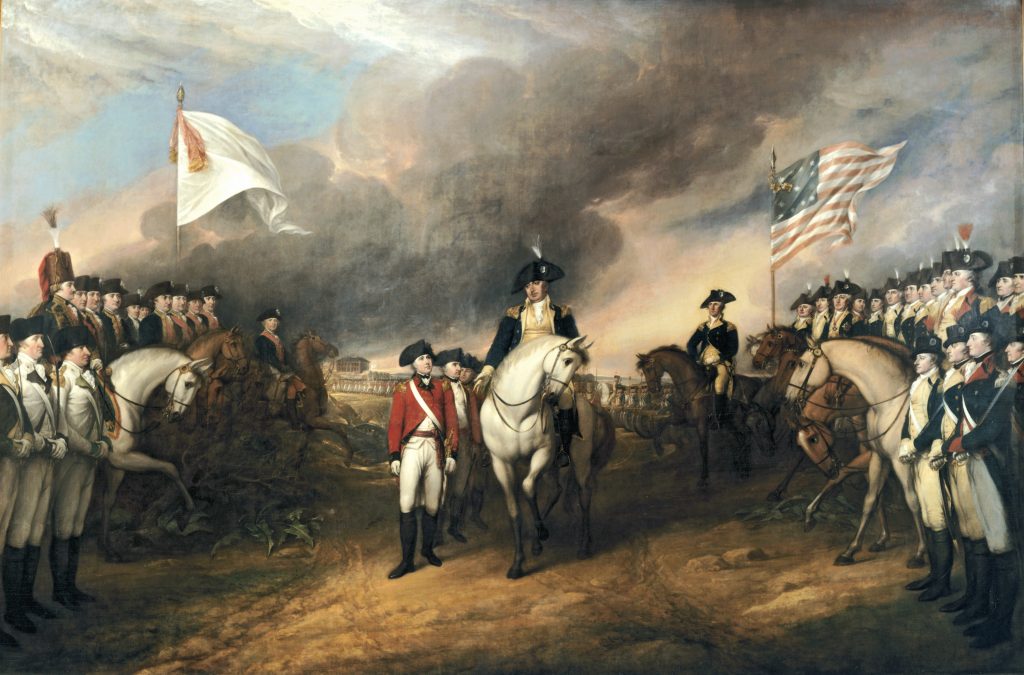1775
“The ministerial Troops gain’d the Hill but were victorious Losers. A few more such Victories and they are undone …
They have dearly paid for one Mile’s Advancement, and before they get another I much doubt if they will have Soldiers enough left to maintain it.”
– Massachusetts lawyer William Tudor to John Adams after the Battle of Bunker Hill
April 19
When British troops attempted to confiscate Patriot military supplies, armed conflicts broke out between the British regulars and groups of Massachusetts militia. While the British destroyed various supplies, the militia forced the British back into Boston, beginning a nearly eleven-month siege. This action is considered the start of the Revolutionary War.
June 17
After Patriot leaders learned that British regulars planned to fortify several key hills surrounding Boston Harbor, a Patriot force built a redoubt on nearby Breed’s Hill. On June 17, 1775, British forces attacked the Patriot defenses. Following two failed attacks the British launched a successful third attack, after many of the Patriot militia had expended their ammunition. Though the British won the battle, they did so at a heavy cost.
June 19
Based on his previous military experience in the French and Indian War and the hope that selecting a commander from the South would unify the colonies, the Continental Congress appointed George Washington Commander-in-Chief of the Continental Army. On July 3, Washington arrived to take command of the Continental troops surrounding Boston.
November 7
John Murray, 4th Earl of Dunmore (Lord Dunmore), royal governor of Virginia, signed a proclamation offering freedom to any enslaved person in Virginia who fled their master and joined the British cause. It is estimated that up to 2,000 enslaved people may have responded. Dunmore’s Proclamation enraged Virginians and swayed many to the Patriot side. Dunmore, unable to maintain British rule in Virginia, left the colony with about 300 formerly enslaved people in 1776.
1776
“We hold these truths to be self-evident, that all men are created equal, that they are endowed by their Creator with certain unalienable Rights,
that among these are Life, Liberty and the pursuit of Happiness.”
– Thomas Jefferson, Declaration of Independence
MARCH 17
The British evacuation of Boston was George Washington’s first victory as Commander-in-Chief of the Continental Army. During the winter of 1775-76, Henry Knox led an expedition to move artillery captured from Fort Ticonderoga to Boston. When Patriot forces occupied Dorchester Heights overlooking Boston Harbor, the British decided to leave the city for Nova Scotia, evacuating on March 17.
JUNE 28
Patriot forces successfully defended Charleston, South Carolina at the Battle of Sullivan’s Island. The spongy, absorbent nature of the palmetto logs used in building the American fortifications aided the American victory by minimizing the impact of British artillery. This battle, combined with the American victory against North Carolina loyalists at Moore’s Creek Bridge on February 27, 1776 secured the southern colonies from British rule for the first several years of war.
JuLY 4
The Second Continental Congress formally adopted the Declaration of Independence on July 4 after voting for independence two days before.
AUGUST 27
The Continental Army suffered a major defeat at the Battle of Long Island. They would ultimately be forced to forfeit New York City to the British, with the city serving as a British stronghold for the rest of the war. By late December 1776, Washington’s army was pushed back to the Pennsylvania side of the Delaware River, leaving much of New Jersey in British control.
DECEMBER 26
After crossing the Delaware River, George Washington attacked the Hessian garrison at Trenton, New Jersey. On January 3, 1777, Washington secured another victory over the British at Princeton. This series of victories, commonly known as the “Ten Crucial Days,” helped revive the Patriot cause and likely saved the Continental Army from dissolution.
1777
“It is a much easier . . . to draw remonstrances in a comfortable room by a good fire side than to occupy a cold bleak hill
and sleep under frost and snow without clothes or blankets. Although they seem to have little feeling for the naked and distressed soldier,
I feel superabundantly for them, and from my soul pity those miseries, which it is neither in my power to relieve or prevent.”
– George Washington, responding to Congress’s criticism of the Army
SEPTEMBER 11
During the summer of 1777, British forces under Sir William Howe sailed into the Chesapeake Bay and landed at Head of Elk, Maryland to approach Philadelphia from the south. On September 11, Washington’s forces battled Howe’s army about 25 miles southwest of Philadelphia at Brandywine. After a hard-fought battle, Howe’s army defeated Washington, and captured Philadelphia on September 26.
OCTOber 17
After attempting to divide the New England states from the Mid-Atlantic by marching down the Hudson River from Canada, British General John Burgoyne surrendered his army to General Horatio Gates. Considered a major if not the most significant turning point in the war, this victory at Saratoga, New York helped convince French King Louis XVI to formally support the cause of American independence.
NOVEMber 15
Congress adopted the Articles of Confederation and Perpetual Union—although they were not ratified until 1781. This government would ultimately be replaced by the republic laid out by the 1787 Constitutional Convention.
DECember 19
Washington’s army encamped at Valley Forge, Pennsylvania. While there, Washington attempted to improve the army’s supply logistics. Arriving in February, the Prussian-born Baron von Steuben greatly improved the drill and discipline of the Continental Army.
1778
“The essential and direct End of the present defensive alliance is to maintain effectually the liberty, Sovereignty,
and independence absolute and unlimited of the said united States, as well in Matters of Gouvernement as of commerce.”
-Treaty of Alliance with France
FEBRUARY 6
Negotiated by Benjamin Franklin, Silas Deane, and Arthur Lee, the Treaty of Alliance with France stipulated French military support would be provided to the United States if Britain declared war on France. Fighting between the two European nations began soon afterward and the Revolutionary War entered a new phase as part of a larger international conflict between France and Great Britain.
JUNE 28
The alliance between the United States and France forced British leaders to consolidate their forces in North America. The British under Sir Henry Clinton leave Philadelphia for New York City. The Continental Army shadowed British movements and fought a large yet inconclusive battle near Monmouth Court House, New Jersey. Although the British army escaped intact, the Continental Army fought well, indicative of the discipline and efficiency sharpened at Valley Forge.
DECEMBER 29
With a stalemate in the north, British leaders formulated a “southern strategy,” hoping to restore royal authority in the southern states. Part of this strategy rested on the idea that most people in those states were still loyal to Great Britain and would peacefully submit to royal authority. On December 29, 1778, British forces under Lieutenant Colonel Archibald Campbell successfully captured Savannah, Georgia.
1779
“I could not reach the commodore’s ship until seven in the evening being then within pistol shot when he hailed the Bonhomme Richard.
We answered him by firing a whole broadside. The battle being thus begun was continued with unremitting fury . . .
Both ships were set on fire in various places and the scene was dreadful beyond the reach of language . . . The British colors were struck at half an hour past ten o’clock.”
– Captain John Paul Jones
JULY 16
In a daring nighttime attack, Brigadier General Anthony Wayne captured the British fortifications at Stony Point, New York. Although the position was soon abandoned, this action, in addition to the raid on Paulus Hook in August by “Light-Horse” Harry Lee, greatly increased morale among Patriot forces. Congress awarded medals to both Wayne and Lee for their victories.
September 23
John Paul Jones wins a spectacular battle as commander of the U.S.S. Bonhomme Richard against the H.M.S. Serapis off the east coast of England, famously declaring “I have not yet begun to fight.”
OCTOBER 20
After a nearly month-long siege followed by a poorly planned attack, the combined French and American forces of General Benjamin Lincoln and French Admiral Comte d’Estaing abandoned their attempt to recapture Savannah. This defeat, along with the failure of French and American forces to retake Newport, Rhode Island, led to temporary disappointment in the French-American alliance.
1780
“I hasten to impart to you the happiness I feel at the welcome news of your arrival; and as well in the name of the American Army
as in my own name to present you with an assurance, of our warmest sentiments for Allies, who have generously come to our Aid.”
– George Washington to General Rochambeau
MAY 12
In one of the worst American defeats of the war, General Benjamin Lincoln’s force of more than 3,000 men surrendered to the British under Sir Henry Clinton at Charleston, South Carolina. The largest capitulation of American troops during the war, the surrender temporarily eliminated Continental forces from the south.
July 11
General Rochambeau, with 6,000 French soldiers, arrived at Newport, Rhode Island. Although many citizens were fearful of the presence of such a large foreign army on American soil, tensions settle and a lasting partnership was formed between the French and American forces.
AUGUST 16
American militia and Continental reinforcements under the command of General Horatio Gates were routed by Charles Cornwallis at the Battle of Camden, South Carolina. Foreign-born General Johann DeKalb was mortally wounded attempting to rally his American troops. Despite this major defeat, southern militia commanders such as Francis Marion and Thomas Sumter continued to harass British forces, giving them a tenuous hold in the Carolina backcountry.
1781
“After breakfast, on the nineteenth, we were marched onto the ground and paraded on the right-hand side of the road,
and the French forces on the left. We waited two or three hours before the British made their appearance.
They were not always so dilatory, but they were compelled at last, by necessity, to appear, all armed,
with bayonets fixed, drums beating, and faces lengthening. They were led by General O’Hara,
with the American General Lincoln on his right, the Americans and French beating a march as they passed out between them.
It was a noble sight to us, and the more so, as it seemed to promise a speedy conclusion to the contest.”
– Continental Army soldier Joseph Plumb Martin on the British surrender at Yorktown
JANUARY 17
American militia and Continentals under the command of General Daniel Morgan destroyed a 1,000-man force of British and Loyalist troops under Lieutenant Colonel Banastre Tarleton at the Cowpens, South Carolina. This defeat not only increased American morale but caused the British to reevaluate their southern strategy.
MARCH 15
Lord Cornwallis, determined to find and destroy the American army commanded by General Nathanael Greene, chased his forces through North Carolina to the Dan River. Both armies met on March 15 at Guilford Court House, North Carolina. Although Greene’s army was forced to retreat, Cornwallis’s army suffered irreplaceable casualties. After marching to Wilmington to rest and refit, Cornwallis decided to invade Virginia.
OCTOBER 19
Cornwallis’s position at Yorktown on the Virginia peninsula gave French and American forces an opportunity to surround Cornwallis by both land and sea. French Admiral DeGrasse’s naval victory prevented British ships from reinforcing Cornwallis, and allowed George Washington and French commander Rochambeau’s combined French and American army to lay siege to Yorktown. On October 19, 1781, about 8,000 British troops laid down their arms concluding the last major battle of the Revolutionary War. On September 3, 1783, representatives of Great Britain and the United States signed the Treaty of Paris, ending the war and establishing British recognition of the United States of America.
